What 4 Months of Off-Season Strength Training Did for This Baseball Program
Results and data speak for themselves.
In this article, I will be breaking down the results of 8 baseball teams ranging from 13u to 18u which we had the pleasure of working with this off-season and winter here at Champion Physical Therapy and Performance. I will provide examples and how to’s of several exercises as well! See how this baseball program increased power, strength, and performance!
If you are not a subscriber to Esposito Strength Club, make sure you click here to subscribe so you don’t miss out! You will also get access to all my Free Online Baseball Courses!
Why We Tested Our Athletes
First off, we like to test and collect data for many reasons. The main priority for us is knowing whether our program was successful or not successful.
I am a true believer in assessing myself as a strength coach and if something was implemented that did not achieve the results I would want or expect, I definitely don’t want to continue to make the same mistake the next year! As a coach, we also have to progress and develop our programs and coaching abilities.
What Data?
This is an area which I don’t know why many programs or coaches do not implement.
It’s all about your athletes getting better right? A huge game changer for us once the off-season ended was handing out progress reports of starting and ending data for each athlete. We held team meetings where we discussed results, goals and much more.
What’s even more important is the kids continued to train even after their “program” ended. This is awesome as many kids just simply stop training during the season.
Don’t make that mistake of not training! For more on that Click here for 5 Mistakes Baseball Players Make in-Season
I believe there are two main excuses as to why most don’t test their athletes…those are:
- You don’t have (make) time.
- You are afraid you and your coaching philosophies will be proven wrong.
Look, I get it from a time perspective, but you are in full control of the practice plan and strength program. You make the time!
If you are afraid of being shown your training program really wasn’t as effective as your marketing led that to be…well either grow and make changes or stop coaching.
The Other End of the Spectrum
While testing can be a great thing, I do need to touch on the other end of the spectrum: over analyzing or collecting data just to say you collected it.
I have seen it before. I have seen some of the most unnecessary tests and assessments performed. I don’t know who actually cares to measure or needs to know the hand size of a 10-year-old baseball player but I’ve seen it done.
Sick, your 11 now and your hand grew 1/8 of an inch, our training is so good…
Was it the training that caused that? Probably not as much as the sun going up and down a whole bunch.
Look, that even happened in our off-season tests. We measured the athletes’ height…but I did not include it on the final reports, many kids are in puberty and maturing…that’s a VERY big variable for me to say had nothing to do with getting taller.
If you are going to collect data, use it! Find out what went right, what went wrong, and how to make adjustments to help the athletes next season!
What We Tested
As we entered the off-season training, we needed to make a list of tests and measurements that were:
- Applicable to the athletes
- Made sense for baseball players
- Able to be consistently replicated
- Take 3 Sessions to perform
- We did not want to lose too many training days
Our Training Parameters
I wanted to break this down a bit more for the coaches and parents who run baseball programs. I am sure some of you have a similar layout to roster structure.
- 8 Total Rosters
- 120 Total Athletes
- 3 days a week of Strength Training
- 1 Hour Per Training Session
- 4 Total Months
- 48 Total Workout Sessions
- 6 of those sessions were allocated to testing, goal setting, and result breakdown and exit meeting
What We Tested
During the first week (November) and last week (February/March 15) of the strength program, we measured the following:
- Body Weight
- Grip Strength on Right and Left Hand
- 60 Yard and 10 Yard Sprints (weather permitting)
- 300 Meter (weather permitting)
- 5-10-5 Pro Agility Test
- Broad Jump
- Lateral Bound on Left and Right Foot
- Vertical Jump Height
- Med Ball Stepping Overhead Throw
We used the GFlight to measure jump height. I absolutely love the GFlight. It’s portable, convenient, and consistent with its data and performance. Here’s a recent post for more and my review. Want a GFlight? Pick one up here and use code ESPOSTRENGTH for savings!
For velocity readings for the Med Ball Throws, we used Pocket Radar. Similar to the GFlight, it was easy to use, portable, and consistent. Here’s a great post from Mike Reinold on 3 Ways Pitcher’s can use radar to enhance performance…and check out the flame-throwing lefty in his videos…
Some of the goals of the baseball program were to simply get bigger and stronger. We only had an hour with the teams, and one of the areas we chose to not allocate much time to was speed and agility. As a strength coach, I do know many of these kids are multi-sport athletes, so that was not a major concern for me. Playing basketball, hockey or other sports gives plenty of agility and footwork.
We also know there is a high carryover when you perform strength lifting and plyometrics that translate into force production of sprinting and change of direction.
We chose several power development markers (broad jumps, lateral bounds, vertical, med ball) to track. We know these have a very strong correlation to baseball players performance and development.
Estimated 1 Rep Max
For our older athletes (15u, 16u, 17u, 18u) we used an estimated 1 Rep Max (e1RM) to safely find working weights for athletes. This also lets us have a better idea of appropriate weight selection for athletes, without the risk of performing a true 1 rep max test.
Every phase of the off-season for the older teams was specific in regard to developing strength and power and then using the new found strength to become explosive. This helps translate to on-field performance!
We had 3 main exercises we chose to track e1RM. Those were pushups, squats, and deadlifts.
Want to know your estimated 1 rep max…bookmark this link and use this 1 Rep Max Calculator
Here are some videos of the testing we performed this off-season!
The Results
These kids absolutely crushed their lifts. We were very clear from the beginning that the results would not happen overnight. Showing up consistently, lifting with good form, and properly increasing their weights was a great start.
While we had great results across all of the testing data, some of the areas that stood out were the power development of the Broad Jump, Vertical, and Lateral Bounds. On top of that, we created very good symmetry in the body from Right to Left on both Lateral Bounds and Grip Strength
We had a 42.98% increase in Right Leg Lateral Bound. For right-handed hitters and throwers, that is HUGE. More force to generate with will translate into higher velocity, and more power when hitting!
One of the other benefits to note is many athletes gained body weight during the off-season. While we gained weight, we also increased all power metrics…AND our running numbers either stayed at the baseline or improved. Even though we gained weight, our running did not get slower!
See the charts below for a full breakdown by age group!

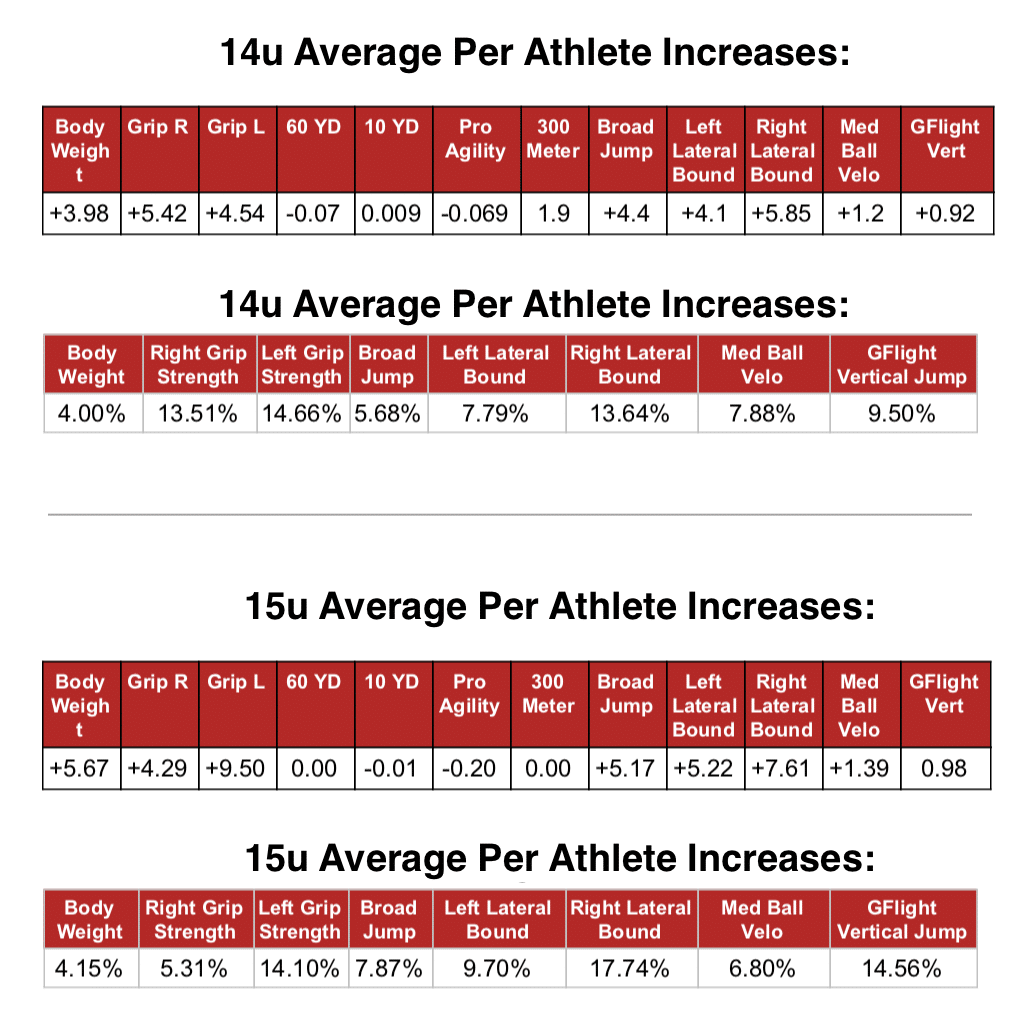
How We Got Results
#1 Item that helped with results: showing up! That was something that was awesome this off-season. Almost all of these athletes were committed to coming to the gym and 100% bought into their personal development!
With that set, setting the foundations for this year and long term success was our top priority for these athletes. The programs were designed to hit the major areas for youth and developing athletes:
- Strength and Power
- Stability
- Proprioception
- Force Acceptance
- Force Development
- Med Ball Work
- Plyometrics
We focused on what I call the pillars of strength: push, pull, hinge, squat, carry, core, balance. All of our workouts incorporated some type of movement or skill associated with those pillars.
Program Design for 13u and 14u Players
For our youth athletes, we always focus or the learning and mastering the basics. For a vast majority of this age group, it was their first time lifting or following a sports performance program.
This age group sets the tone and prepares them for heavier loads at older ages. You will be way ahead of everyone when you get into your 15 and older range from a strength development perspective.
We kept our rep ranges in the 8-12 for most of the exercises and focused on quality over quantity. Our progressions were designed to maintain their focus during the entire lift to be self-aware of their movement and patterns. For example, using 1 weight in a contralateral hold challenges your lateral flexion while performing a reverse lunge. This is a great progression for a standard reverse lunge.
Program Design for 15u, 16u, 17u, 18u Players
We had 4 significant phases for this age range during the off-season.
- Phase 1 was re-acclimating to the gym after time off, as well as ensuring the lifting movements were ideal!
- Phase 2 was continuing on our linear progression and added in some Isometric holds, and preparing the body to accept heavier loads.
- Phase 3 was our heaviest load phase. We reduced the number of reps and increased the number of sets. This allows to safely get under heavier loads all within a linear progressive training approach!
- Phase 4 was our speed phase. We take the muscle and strength we gained during the previous 12 weeks, and we teach it to become explosive and powerful. We reduce the weight as well to provide the proper stimulus for training, and prepare for tryouts and the season!
Just a note, we did not progress the athlete to the next phase just because the program called for it. This was where we would individualize for the athlete. If they required more time to master a movement, we simply allowed them that additional time.
How to Videos
Here are some great demos and how to videos of some of the exercises we used through the off-season training program. Many of these were crucial to power development as the data shows!
Final Thoughts
This was a great off-season for these athletes as the data shows. It was awesome seeing the progress from start to finish. Thanks to everyone at Champion (Kiefer, Diwesh, Kristy) for being a huge part of the success of these athletes!
We were very excited to show all the athletes at the end of the year meeting their results. It was great to see the kids talk about their goals and seeing their faces when they realized how they did not just hit their goal, but absolutely crushed it.
If you are interested in this type of training and results for your teams, send me a message below!
Nick Esposito
Latest posts by Nick Esposito (see all)
- 5 Sprint Drills Designed for Baseball Players - October 8, 2019
- Nutrition for Baseball Performance - September 10, 2019
- The 3 Foundations to Your Nutrition: Macronutrients - August 13, 2019

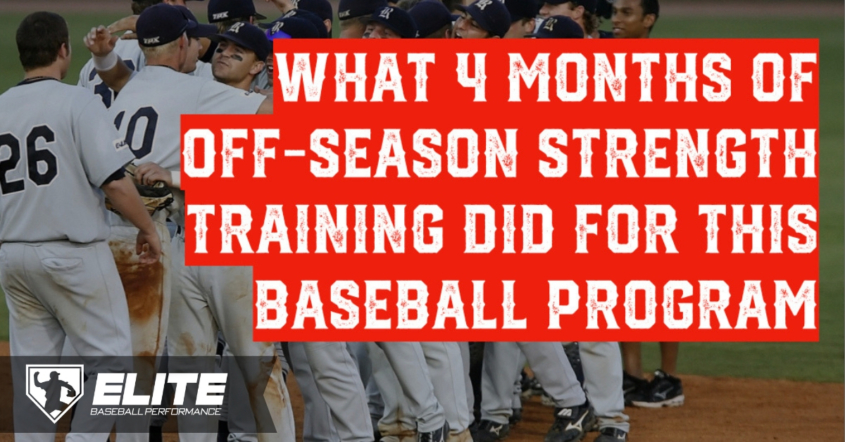

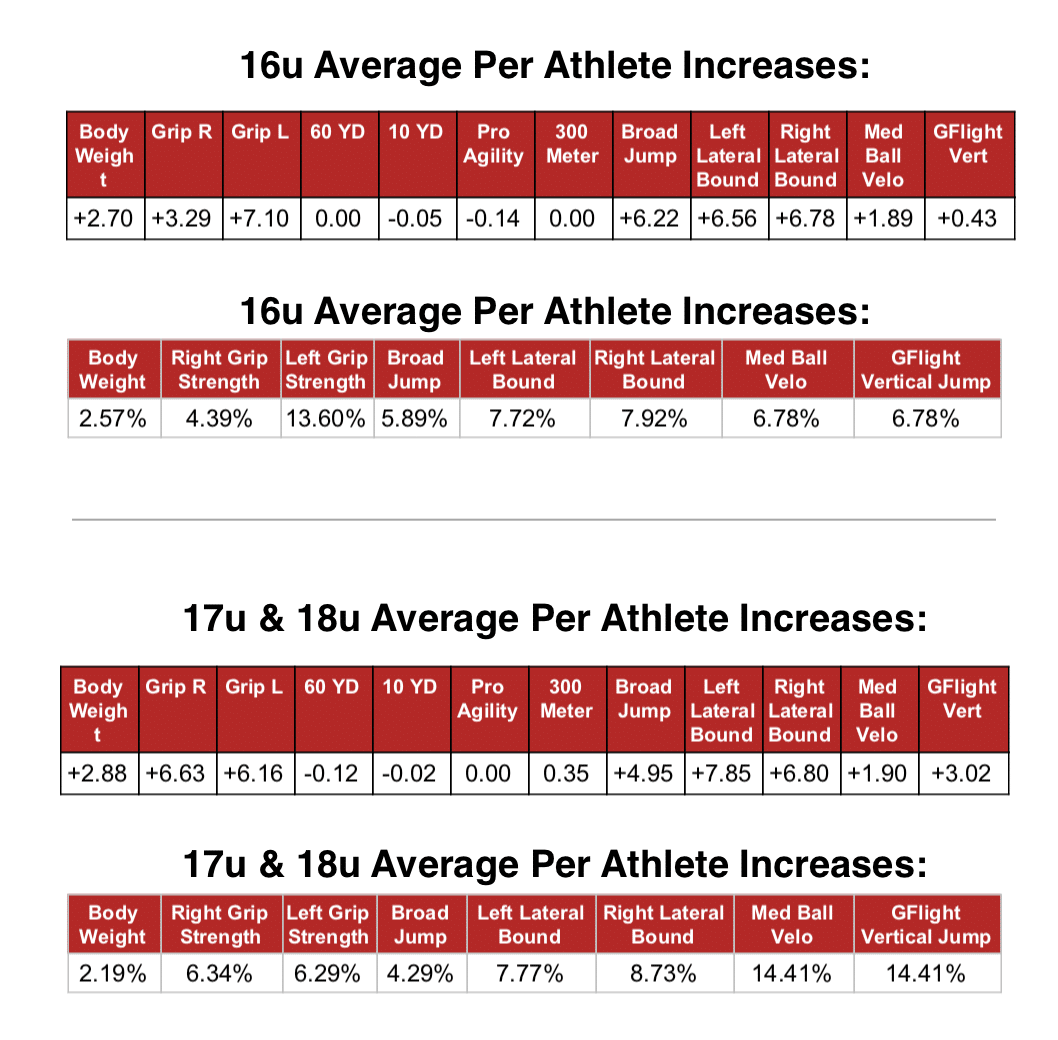
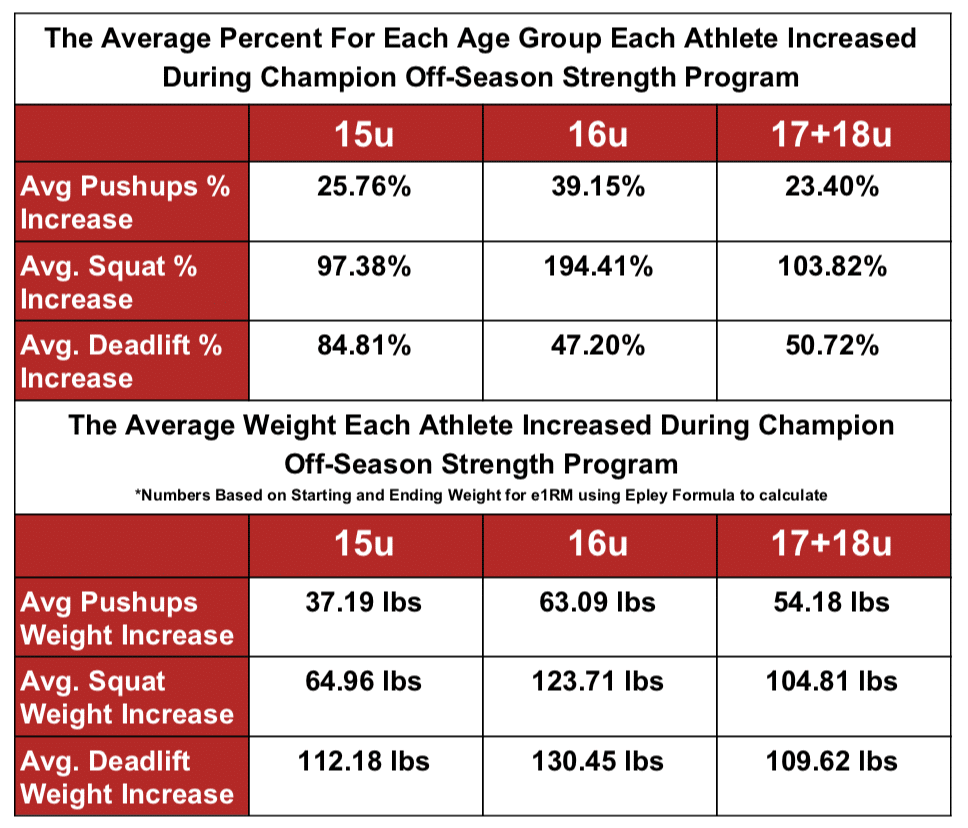



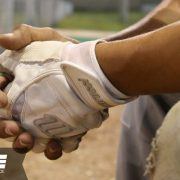
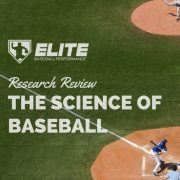
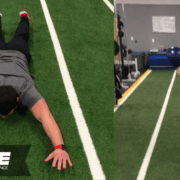
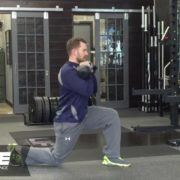


My little guy just turned 8, and is really getting into baseball. Since he is so young, what goals would you suggest we set for off season training? We live in a place where it is very cold outside during the off season, and I would hate for him to loose everything he gained during the season.
Honestly, for someone as young as 8, I would recommend continuing to play as many sports as possible while having the most fun he can. For youth athletes, consistency is key so that could be a good goal to start off at.